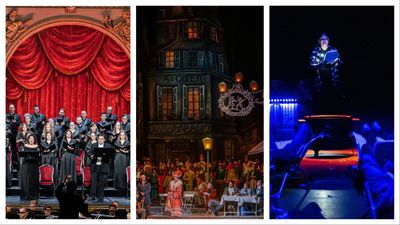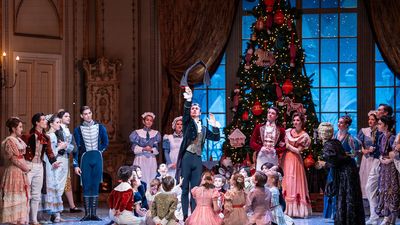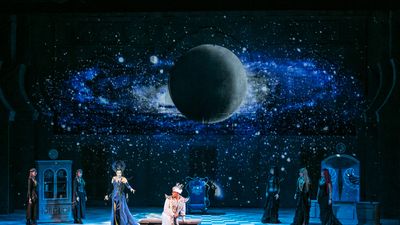
A cast of more than three hundred performers will perform the monumental oratorio Gurre-Lieder by Arnold Schönberg, born 150 years ago, on 15 February 2025 at the Erkel Theatre. The grand finale of the late Romantic period, rich in Wagnerian and Mahlerian elements, which has only been performed twice in Hungary before, will be performed by the Hungarian State Opera Orchestra and Chorus, conducted by internationally renowned conductor Henrik Nánási, with the participation of soloist István Kovácsházi, Tünde Szabóki, Atala Schöck, Zsolt Haja, Gerely Ujvári, and Dénes Gulyás.
Forbidden love, natural images, murder, curses, the deadly pursuit of the dead... Based on the medieval legend of the tragic story of King Valdemar I of Denmark and his lover Tove, Danish writer Jens Peter Jacobsen wrote a poem cycle entitled Gurresange in the late 1860s, the grandiose adaptation of which by Arnold Schoenberg is considered one of the pinnacles of late Romanticism. Schönberg, who was influenced in his youth by the works of Richard Wagner, including Tristan und Isolde, originally sought a theme for a Viennese composers' song competition in 1900, and after missing the submission deadline, he radically revised his song cycle written for piano and vocals, thus creating one of the most demanding oratorios, alongside Mahler's Symphony No. 8 and Britten's War Requiem.
Gurre-Lieder, coloured with dramatic orchestral interludes that show Wagnerian and Richard Straussian, and Mahlerian influences later on, is now being featured on the Hungarian State Opera's programme on the occasion of the 150th anniversary of Schönberg's birth, and will be performed by an orchestra of more than 150 members and a chorous of about 150 members (chorus director: Gábor Csiki). In what promises to be an unrepeatable event, the OPERA ensembles will be conducted by Henrik Nánási, who made his debut at the helm of the ensemble when he conducted Verdi's Requiem in 2023. The conductor, born in Pécs, is not only employed by the world's leading opera houses, but is also active as a concert conductor from Japan to Europe to the United States. Nánási, who is particularly attached to 20th-century music through his studies as a composer, said in connection with the concert that he considers it important for as many people as possible to get to know this cathartic work: "Gurre-Lieder is a synthesis of musical literature in which all musical trends of the era are combined. Many people may be skeptical when they hear the name Schönberg, but when they listen to it, they encounter something absolutely beautiful. I would like the audience to receive it with the surprise and enthusiasm that this exceptional piece deserves.” The soloists' roles comparable to Wagnerian figures are performed by István Kovácsházi (Waldemar), Tünde Szabóki (Tove), Atala Schöck (Wood Dove), Zsolt Haja (Peasant), Gergely Ujvári (Klaus the Jester), and Dénes Gulyás (Narrator). The monumental production will be accompanied by screenings by Zsombor Czeglédi. The concert is also expanded with special additional content: in view of the extraordinary occasion, the OPERA will officially bid farewell to the Erkel Theatre, which was a venue of the Hungarian State Opera from 1949 to 2024, i.e. for 75 years.
A brief introduction to Gurre-Lieder
In the first part of the almost two-hour-long Gurre-Lieder, divided into three units, King Waldemar and his lover Tove tell of their love for each other in nine songs rich in natural imagery, which, after a musical interlude, closes at one of the climaxes of the piece with the Song of the Wood Dove. In this, the bird narrates the king's restless grief over the death of Tove, and that the jealous queen is responsible for the girl's death. In the interlude-like second part, Waldemar, in his anger, condemns God's cruelty for the loss of his love. As punishment, the king is cursed: in the third part, he must gallop through the countryside at night at the head of his dead soldiers. While Waldemar continues to mourn Tove, the men's chorus embodies the terrifying raiding army of the undead. Their speeches are interrupted by the terrified song of a Peasant and the lamentation of Klaus, a jester who involuntarily gets involved in the chase as a comic element. As dawn approaches, the dead return to their graves, and at the end of the play, the Narrator recounts the natural equivalent of the mystical events, the wild chase of the summer wind, which ends with a chorus greeting the rising sun. The scene of the events is Gurre Castle, a former Danish royal residence, the ruins of which are located north of Copenhagen, just a few kilometers from the Helsingør home of another legendary literary figure, Shakespeare's Hamlet.
Gurre-Lieder was premiered in 1913 at the Vienna Musikverein to great acclaim, but due to its extraordinary orchestral and choral size and virtuosity, the oratorio is still considered an event to this day. The Hungarian premiere took place 85 years after the premiere, in 1998, at the Budapest Spring Festival, when Zoltán Kocsis conducted the piece at the head of the National Philharmonic Orchestra supplemented by the Hungarian Radio Chorus and the Honvéd Male Chours at the Budapest Congress Center, with soloists Mária Temesi, Márta Lukin, Garry Bachlund, Benno Schollum, and István Rozsos. The oratorio was last heard almost twenty years ago, in 2006, in a performance by German radio orchestras and choruses at the newly opened Müpa, conducted by Michael Gielen.
Photo by J Henry Fair


